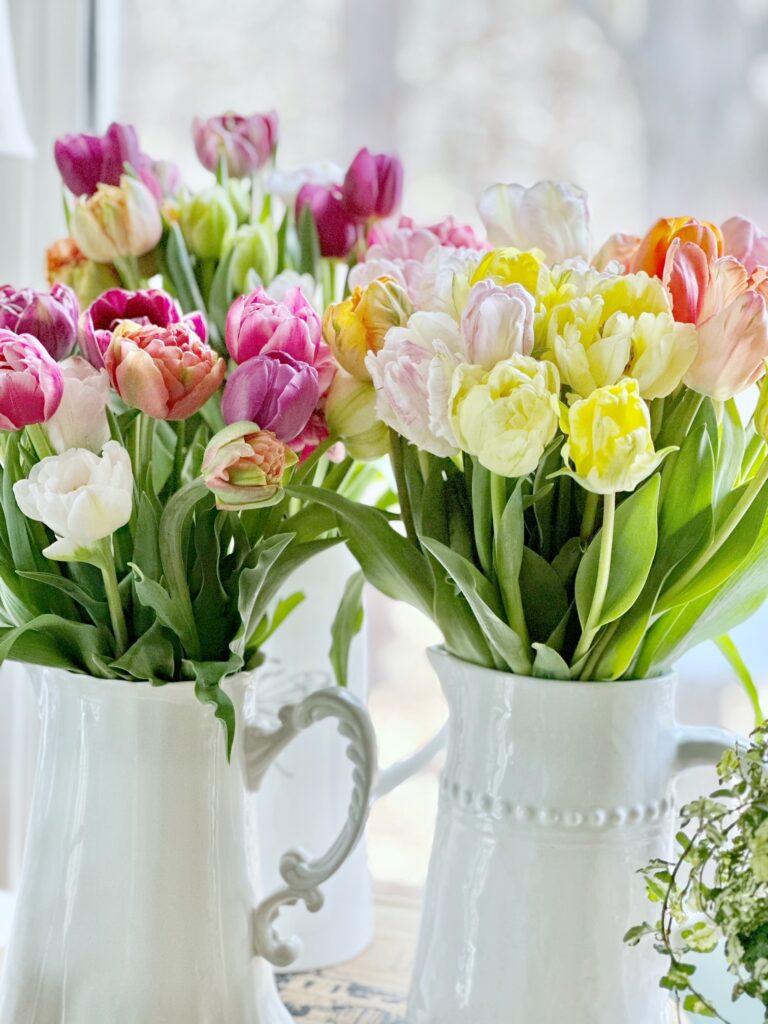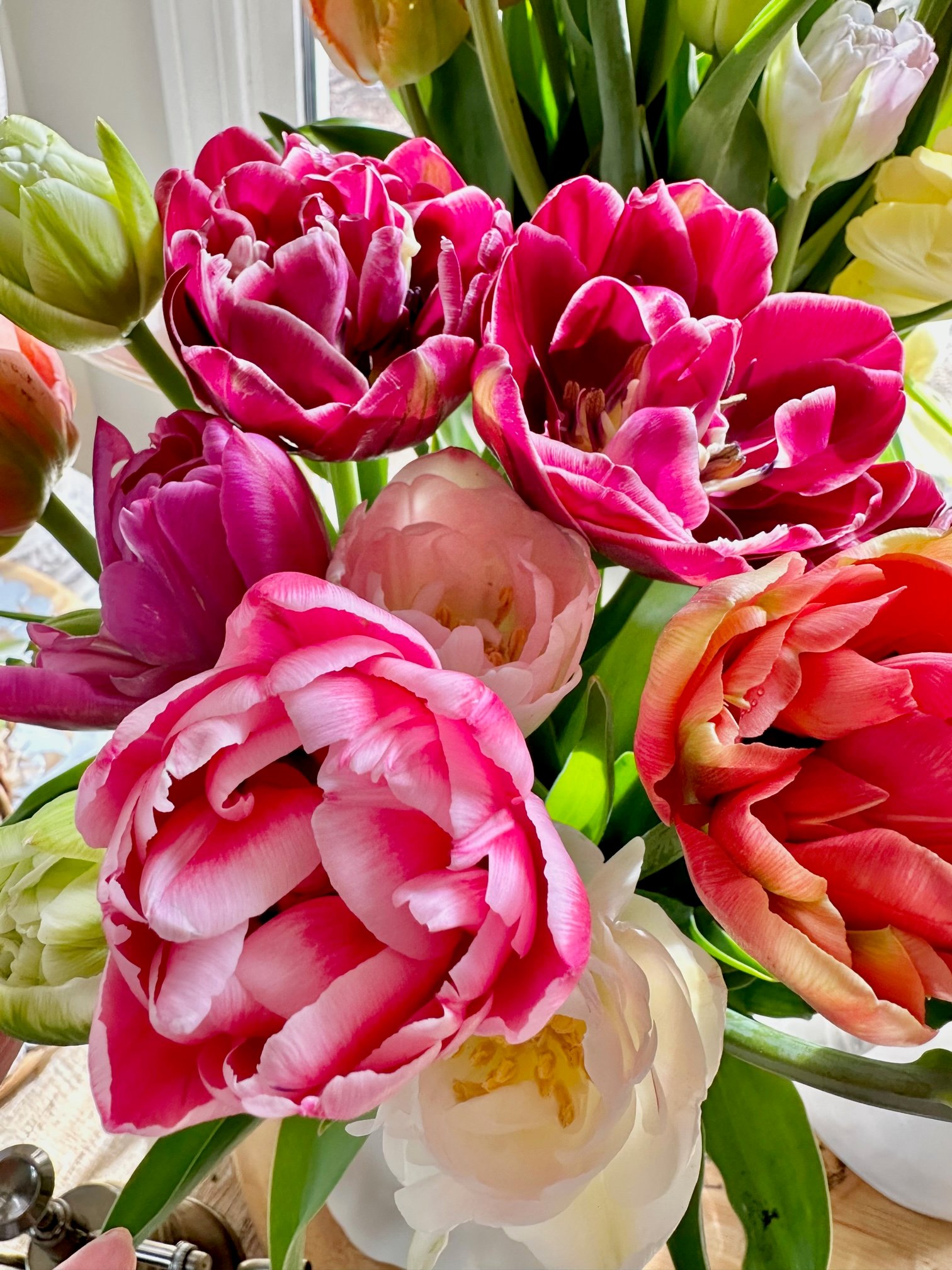Tulips are drama queens. One minute they’re standing tall, the next they’re flopped over the vase like they’ve given up. The good news? You can stop the droop (and stretch) before it starts.
As a florist, I’ve used this simple trick for years to keep tulips from bending or stretching. It’s quick, it works, and once you know it, you’ll never skip it again. Whether your blooms came from the grocery store or your garden, this method helps them stay perky and picture-perfect for days.

Content may contain affiliate links. When you shop the links, we receive a small commission at no cost to you. Thanks for supporting my small business.
Jump to:
- Why do tulips droop in the first place?
- How to keep tulips from drooping
- Bonus tip: how to prevent tulip stems from stretching
- Common mistakes that make tulips flop faster
- What to do when you bring cut tulips home (the shortlist to prep)
- My top 7 tips for making tulips last longer
- Shop flower frogs to help keep your blooms stay upright
- Frequently asked questions
- More fresh flower care and design tips
Why do tulips droop in the first place?
They keep growing after they're cut
Tulips are one of the few cut flowers that keep growing even after they’re snipped. Because of phototropism, they naturally stretch toward the light, which causes those elegant but sometimes frustrating curves.
Heavy blooms and weak stems
Tulip stems are delicate. When you pair a big bloom with a thin stem, it often can’t support the weight. That’s when you see them start to bend or flop over.
Water level and prep mistakes
If the stems are too submerged or weren’t trimmed properly, tulips can take in too much water or not enough. Dirty water doesn’t help either. It can clog the stems and keep them from drinking, which leads to early drooping.
Warm rooms make it worse
Tulips are sensitive to heat. If they’re sitting in a sunny spot or near a heating vent, they’ll bloom and bend faster than if they were kept cool.

How to keep tulips from drooping
Why tulips move so much
Tulips aren’t your average cut flower. They’re phototropic, which means they bend toward the light. They’re also geotropic, meaning they react to gravity. That’s why your tulips might start out stiff and upright, only to twist and bend in the vase like they’ve got a mind of their own.
Yes, they keep growing
Unlike most flowers, tulips keep growing after they’re cut. Seriously—they can gain an inch or more in the vase. That fresh growth, combined with their natural urge to lean toward sunlight, often leads to stretched stems and droopy heads.
How to keep them standing tall
If you want your tulips to stay upright and elegant, try these tricks:
- Use a tall vase. It gives the stems more support and helps counterbalance the top-heavy blooms.
- Keep the light even. Place the vase somewhere that gets balanced light from multiple angles. This keeps the flowers from leaning hard in one direction.
- Do the florist trick. Just before placing them in water, use a pin or sharp floral knife to make a small slit right below the bloom. Don’t pierce all the way through—just a tiny knick will do. This helps relieve stem pressure and reduces that dramatic droop.
I always do this little step when I first arrange my tulips. It makes a big difference and keeps them looking fresh longer.

Bonus tip: how to prevent tulip stems from stretching
Tulips are one of the few cut flowers that actually keep growing after they're in a vase. It's not unusual for them to gain an inch or more, which can throw off your arrangement and cause stems to droop under the weight of the blooms.
So how do you slow the stretch?
Keep them cool. Warm temps encourage faster growth. A cooler room will help the tulips grow more slowly and keep their structure.
Trim the stems a little shorter. Giving them a fresh cut at an angle helps them take in water, and keeping them slightly shorter helps maintain shape.
Mind the light. Since tulips are phototropic, they lean toward the light. If your arrangement is in a window, rotate the vase daily or place it in a spot with light from multiple angles to keep stems straighter.
Florists often chill tulips overnight or store them dry in a fridge before arranging them. That little bit of cold gives you firmer stems and helps preserve their upright posture.
With just a few tweaks, you can enjoy upright, elegant tulips that hold their shape longer in the vase.

Common mistakes that make tulips flop faster
Some tulips droop no matter what you do. But a few simple missteps can make it happen much sooner than it should. Here are the most common culprits:
Overcrowded arrangements
Too many stems crammed into one vase can cause them to press against each other and bend more easily. Give your tulips some breathing room so they can stand tall.
Cutting too little off the stems
A fresh, angled cut is key. If you only snip a tiny bit or skip it altogether, the stems won’t absorb water properly and may weaken quickly.
Placing them in direct sun or near fruit
Direct sunlight speeds up wilting. And fruit? It releases ethylene gas, which can make your tulips age faster than they need to.
Using dirty vases
Leftover bacteria in a vase can clog stems and shorten vase life. Start with a sparkling clean vase to give your tulips the best chance at a longer, perkier life.
What to do when you bring cut tulips home (the shortlist to prep)
I'm excited to share about my floral designing career and subsequent knowledge and experience with working with tulips but I know, right now you are looking for the shortlist... the to-do list for when you get home with a bundle of tulips. Here's the step-by-step to get those blooms prepped:
- First, unwrap your tulips from the protective sleeve they came in and lay them on your counter or table. With scissors, remove the rubber band or twine the bundle is wrapped with.
- Fill a vase, bucket, or pitcher of cold water and if your tulips came with flower food, add that to the water. The flower food packet will guide you on the food-to-water ratio.
- Handling one stem at a time, begin by stripping ( peeling ) the bottom leaves only leaving the leaves you want for your design. I recommend leaving at least the top leaves since these pretty green spear-like leaves look beautiful in an arrangement.
- Once the leaves are stripped, take a design knife or a pair of scissors cut the flower stem at a 45-degree angle, and place it immediately in the water.
- Move to the next stem and repeat until all the tulips are in the water.
- If this is their final destination, meaning if your arrangement is done place them in a spot where you can enjoy them. Keep in mind tulips will stretch toward sunlight so if placing them near a window you may need to rotate the vase. Otherwise, place them in a spot with indirect sunlight.
- If you're prepping them and plan to design with them later it is best to keep them in a cool dark space until you are ready to make your flower arrangement. This will help extend their vase life.


My top 7 tips for making tulips last longer
1. Selecting the best blooms
Head to any floral department in your grocery store or your local florist and you are sure to find the most glorious bundles of tulips for sale. Tulips come in so many different colors and it's hard to know how to choose the best blooms. Here are a few buying tips. Regardless of the variety or color of the flower, it is wise to buy tulips with flower heads that are closed or have tight buds.
Tulips will mature fast ( a couple of days) once you prep them so starting with tight buds is always a good idea. Make sure the petals aren't transparent and that the greens are a healthy bright spring green color. Older blooms will have open blooms that have transparent or curled edges and the tulip leaves will be a dull green.

2. Removing the leaves
Wrapped tulips come with several layers of leaves. It is important to remove the leaves that will be below the water line. The foliage of tulips tends to get mushy underwater turning the water somewhat murky. Tulips love fresh clean water which is easier to achieve and maintain by removing the lower level of greens.

3. Cutting the stems at an angle
You probably hear this tip a lot but do you know why this is recommended? It is simply to make sure the flower stems do not sit flat on the vase resulting in the tulip not being able to pull up water. Simply grab a knife or sharp scissors and cut the bottom of the stem at an angle. Be sure to re-cut tulip stems every 1-2 days and replace the water.

4. Meeting the cut tulip's water needs
Tulips love fresh water and lots of it. They are thirsty flowers so keeping the water level high and the water clean is important for their vase life. If your tulips came with floral preservative add that to the water. If you are trying to open tulips faster consider placing them in warmer water.
Tips for enhancing the longevity of your tulips:
While I haven't personally tried these methods, some suggest they may help.
- Add a penny to the water: Placing a penny in the vase of water can help to prevent the growth of bacteria and fungi, thus extending the life of your tulips. Note: only pennies minted before 1982 work effectively, as newer pennies are primarily made of zinc with just a copper coating.
- Add an aspirin: Dissolving an aspirin in the water is believed to lower the pH levels, providing an environment that helps to keep the tulips fresh for a longer period.
- Add a couple of dashes of Sprite: Adding a small amount of Sprite to the water can provide nourishment to the tulips, as the sugar in the beverage serves as a source of energy for the flowers, helping them to stay vibrant and perky.

5. Tips to keep tulips from drooping
Understanding Tulip Movement
Tulips are both phototropic (they will grow and move toward a light source) and geotropic (they bend away from the earth due to the force of gravity). What this means is they have a proclivity to seek out the light source and head in that direction or be stiff and stand up straight! This is until the cut tulip stems soften and the heavy heads pull them down. They seem to go from one extreme to the other.
The Growth Factor
Unlike most flowers, fresh-cut tulips continue to grow in the vase even gaining an inch or more in height. This is highly unusual in the cut flower world! Not only do they grow they also reach for the light. As the days pass the fresh-cut tulip stems can no longer support the heavy blooms and that stiff stem that is reaching for the light is now taking a nosedive.
Prevention Tips
To minimize this from happening consider placing them in a space that gets light from all angles. A tall vase will support the stems and help to keep them from flopping. Perhaps the best way to reduce the stretch, grow, droop cycle is to place a small slit on the stem of the tulip right under the bloom. To do this little trick simply take a sharp knife or a pin and pierce the stem. Do not put the knife through the entire stem just a knick or small hole should work. I recommend doing this as you first place the tulips in water.

6. Where to place your arrangement
If placed in direct sunlight you can expect limited vase life. It is best to place them in a space where they are not subject to too much sun. Tulips love cool temps so when a vase of tulips is situated in a cool place it will last longer.

7. Tips for designing
Let's chat about tulips in floral arrangements! You can design tulips in both a clean vase of cool water or in fresh flower floral foam. Tulips do well in both as long as you keep the vessel filled with water or the foam remains saturated. As mentioned above tulips are very thirsty flowers and for the longest vase life make sure they are well watered!
If you're working with a shallow bowl or want more control over stem placement, floral frogs are a fantastic tool. These little mechanics help hold each tulip exactly where you want it, especially if you're going for an airy or ikebana-inspired look.
Whether you're planning a spring centerpiece or designing for a special occasion, tulips shine on their own or mixed with other seasonal blooms. They’re a favorite in wedding bouquets and always a crowd-pleaser for dinner parties.

Shop flower frogs to help keep your blooms stay upright
Frequently asked questions
Yes, sometimes. Try trimming the stems a bit and placing them in cold water for a few hours. Some people also wrap them loosely in paper before putting them upright in water. It doesn't always work, but it’s worth a shot.
If your tulips are flopping, this old florist trick can help. Wrap the bouquet in paper to support the stems, place them in water, and let them chill in a cool spot overnight. They often perk up by morning.
Tall, narrow vases offer the most support and help prevent that dramatic flop. Avoid wide or shallow vessels unless you like the wild, droopy look.
The copper in pennies acts as a natural fungicide and may help keep the water clean. Only pennies minted before 1982 work effectively, as newer pennies are primarily made of zinc with just a copper coating.
More fresh flower care and design tips
This tulip arrangement is one of my go-tos for spring — check out more ideas in my Fresh Flower Design Index.
For more beautiful blooms visit my floral design page where I cover fresh flower design, faux floral design as well as indoor plant design and care! Visit my 8 Must-Have Flower Arranging Supplies for Your Home so you have the tools you need to create beautiful bouquets!
Keep designing friends!











